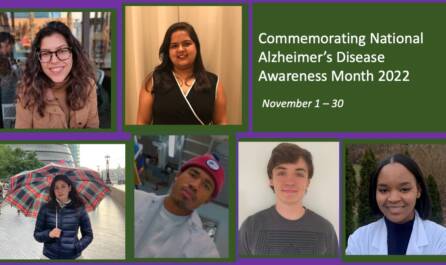Alzheimer’s disease, the most common form of dementia, currently affects more than 6.2 million Americans and around 24 millions individuals globally. In 1983, President Ronald Reagan first designated November as National Alzheimer’s Disease Awareness Month.
To mark the occasion this year, six NYGC staffers consider their roles in understanding the genetics of (and possibly developing treatments for) Alzheimer’s and other complex neurodegenerative diseases. Additionally, here’s a look back at five NYGC staffers reflecting on the National Alzheimer’s Disease Awareness Month in 2020.
For more resources including facts about Alzheimer’s disease, methods to show support and raise awareness, as well as the schedule of events being held this month, please visit November is Alzheimer’s Awareness Month.
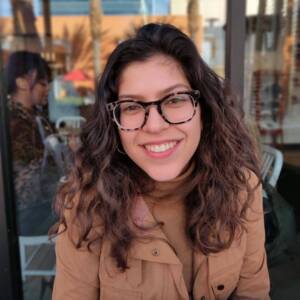
Natalie Barretto
Graduate Student, Phatnani Laboratory
Tell us about your current role at the NYGC.
I am a PhD student in the Neurobiology and Behavior Program at Columbia University mentored by Dr. Hemali Phatnani. My project focuses on understanding the role of microglia in amyotrophic lateral sclerosis (ALS) pathology by using induced pluripotent stem cell (iPSC)-derived microglia and optical screens.
What do you enjoy doing besides work?
When not in the lab, I really enjoy going for a long stroll throughout Brooklyn with a pit stop or two for a good cup of coffee. I also love going hiking upstate, reading on the subway, and live jazz. I recently started taking pottery lessons again and have been throwing on the wheel – so far I have made 7 bowls!
What got you interested in neurodegenerative disease/Alzheimer’s disease research?
During college, I volunteered in a stem cell lab, where I was introduced to iPSCs for the first time. I was, and still am, amazed by all the potential applications of iPSCs, especially from the therapeutic perspective. Thus, my initial interest in neurodegenerative diseases came from realizing the possibility of iPSCs in treating these diseases: can you differentiate iPSCs into the vulnerable cell-type? Ever since, my interest has also grown towards using iPSCs to model and better understand the molecular components underlying neurodegeneration.
What, if any, barriers or challenges have you faced in your career?
I started college with the intention of going to medical school. Then in my senior year I began volunteering in a lab and I enjoyed it so much that I questioned whether medical or graduate school would be better for me. Prior to this exposure in a laboratory environment (besides chem or orgo lab as a pre-med), I had no idea what doing research entailed. To see how collaborative and creative the scientific method was in action was exciting. I spent the next two years completing a research intensive masters to help me figure out which path to take. I ultimately came to the realization that I felt fulfilled doing translational research/benchwork and mentoring, thus graduate school seemed a good route.
What do you think can be done to make the workplace more inclusive and equitable?
One can begin acquiring experience in academic research as early as high school by volunteering in a lab. This volunteering can continue throughout college, however, not all students can continue doing unpaid work, thus narrowing down the pool of those that will and/or can continue in science. Therefore, I think offering more paid internships/experiences early on in academia is imperative – which is something NYGC is very good about, such as through the Centers of Excellence in Genomic Science (CEGS) grant and Levy Foundation.
What advice would you give to your younger self?
Stop feeling like you can’t contribute unless you know everything; it is impossible and unrealistic to know everything. If you do not know or understand something, ask questions!
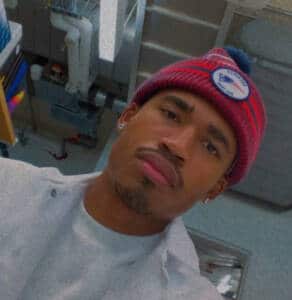
Obadele Casel
Associate Scientist II, Center for Genomics of Neurodegenerative Disease
Tell us about your current role at the NYGC.
Currently, I am an Associate Scientist II in the Center of Genomics of Neurodegenerative Disease (CGND) – Phatnani Lab. My current focus is using spatial transcriptomics technology to analyze histological sections from patients to study neurological disease.
What do you enjoy doing besides work?
I personally love being active, working out, playing basketball/football/soccer, and hiking. Being able to travel to various countries and experience the foods, architecture, nature and overall culture of something new is enthralling and a passion of mine. Lastly, I enjoy engaging in my musical talents by playing my violin and piano any time that I want to immerse myself in a different form of peace.
What got you interested in neurodegenerative disease/Alzheimer’s disease research?
It was during my undergraduate career, where one of my professors introduced the world of psychology and neurobiology to me and almost instantly I was captivated. The human brain, in all of its intricacies or nuances, is truly an amazing thing because of how paramount it is to our lives yet we only understand a fraction of its capabilities. As cliché as it sounds, being a part of the cause that furthers the development of research to ultimately help the general public really is fulfilling.
What, if any, barriers or challenges have you faced in your career?
Coming from industry and going into academic research was definitely a learning curve for me. I had to adjust my thinking tremendously and focus more on the ‘How’ and the ‘Why’ of an experiment. Also being the only scientific/medical professional in my family, there is a certain personal challenge of setting the highest standard.
What do you think can be done to make the workplace more inclusive and equitable?
I think that NYGC does a great job with making the workplace inclusive and comfortable for all parties. I know due to the pandemic that social distancing and masks are still in effect; however, it would be nice if we would be able to have more events to meet some more members of the company.
What advice would you give to your younger self?
Ease is a greater threat to progress than hardship. Also, remove ego from your space, it is perfectly okay to not know something and ask someone for help.
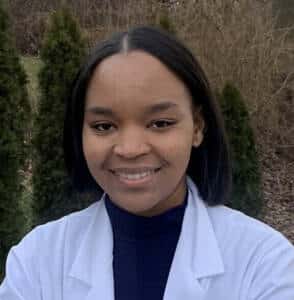
Shaunice Grier
Research Assistant, Phatnani Laboratory
Tell us about your current role at the NYGC.
I’m a Research Assistant in the Phatnani Lab. I perform Visium experiments for the Senescence Project/U54 grant. My role primarily consists of performing Spatial Transcriptomic (ST) experiments, generating ST data on post mortem Human Hippocampus Tissue, making and ensuring quality control of cDNA libraries submitted for sequencing.
What do you enjoy doing besides work?
Enjoying vegan/vegetarian cuisine and discovering new coffee shops and cafes. I also enjoy traveling and listening to podcasts.
What got you interested in neurodegenerative disease/Alzheimer’s disease research?
I’ve always had an interest in pathology and studying/understanding disease. However, my interest in neuropathology began while working/interning in the morgue at the Medical Examiner’s office in NYC and Virginia. I delved further into understanding neurodegenerative diseases by interning at the Taub Institute at Columbia University in the Hussaini Lab and shadowing at the Department of Pathology, Yale School of Medicine with Physician – Neuropathologist Dr. Darbinyan.
What, if any, barriers or challenges have you faced in your career?
Having a background in Forensic Biology, I’ve had to perform and show that my technical training and education has prepared me to succeed and excel in various STEM settings.
What do you think can be done to make the workplace more inclusive and equitable?
More open and honest dialogue about the barriers that exist for underrepresented individuals in STEM. More effective measures and action to diminish those barriers via representation and advocacy.
What advice would you give to your younger self?
Keep going and keep up the good work.
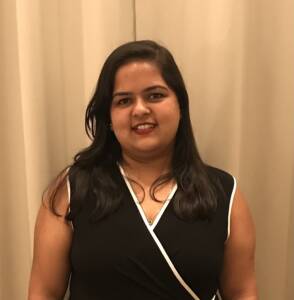
Shruti Khiste
Associate Scientist I, Center for Genomics of Neurodegenerative Disease
Tell us about your current role at the NYGC.
I am an Associate Scientist in Dr. Hemali Phatnani’s lab, the Center for Genomics of Neurodegenerative Disease (CGND). I am part of the Visium workflow and working on a project focused on applying 4i multiplexed immunofluorescence imaging to diverse types of tissues.
What do you enjoy doing besides work?
Some of my interests are painting, music, and dancing. I am currently getting trained in Indian classical dance and hope to get a degree to start dance school.
What got you interested in neurodegenerative disease/Alzheimer’s disease research?
I admit that I do not have a strong background in neurodegenerative disease but during my undergraduate, I worked on a literary research project “RNAi to treat Alzheimer’s.” I believe that the brain is the most important asset we have but there are so many questions that are yet to be answered. Also, there are so limited therapeutic options available for patients with neurodegenerative disease. This led me to explore my interest in this area of research.
What, if any, barriers or challenges have you faced in your career?
I am pursuing my master’s from NYU as well. Sometimes it is challenging for me to have work-life balance but it is also helping me to build time management skills. Moreover, I came from an industrial lab to academic research. The transition was a little tough as things are handled differently in an industrial lab than in an academic research lab. I am grateful to all the mentors who supported, encouraged, and guided me.
What do you think can be done to make the workplace more inclusive and equitable?
I think the workplace could be more inclusive and equitable by giving opportunities to candidates fresh out of college with little to no lab experience and having open conversation about issues of diversity and inclusion.
What advice would you give to your younger self?
Don’t hesitate to take risks and ask questions!
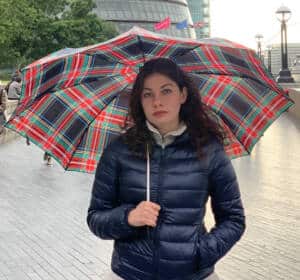
Olena Kuksenko
Graduate Student, Phatnani Laboratory
Tell us about your current role at the NYGC.
I’m a graduate student in Dr. Hemali Phatnani’s lab at Columbia, where I study the molecular mechanisms of ALS using mouse models. We collaborate with Dr. Neil Shneider to better understand how different genetic pathways contribute to motor neuron loss in an aggressive, juvenile onset model of ALS. I’m using spatial transcriptomics and multiplexed protein imaging methods to examine how this dysfunction arises in different cellular neighborhoods, and how gene expression changes in response to treatment.
What do you enjoy doing besides work?
One of my favorite parts of being a graduate student is introducing high school and undergraduate students to laboratory research. For many mentees, this is their first exposure to experimental research outside of a regimented laboratory course, where all experiments are designed to work perfectly. It’s often also their first time working in an environment where things frequently don’t go according to plan and failure is the norm. I enjoy helping young researchers realize their full potential and watching them master things they once thought were impossible. I find mentoring very energizing – it’s incredibly fulfilling to see my mentees take ownership of their work, learn to troubleshoot experiments, peruse the literature, defend their findings, and explain the implications of their results to their peers and professors. Outside of research, I love going on long strolls, losing myself in fiction or a good audiobook, exploring new places and trying different food. I also collect and consume alarming amounts of tea.
What got you interested in neurodegenerative disease/Alzheimer’s disease research?
In the past couple of decades, life expectancy has increased, and so has the prevalence of neurodegenerative disease. While there is a correlation between aging and neurodegeneration, it’s unclear what exactly makes some individuals more susceptible to these diseases than others. I’m interested in better understanding the dysfunction that occurs at a cellular and molecular level and how it contributes to this selective vulnerability.
What, if any, barriers or challenges have you faced in your career?
When I immigrated from Ukraine at the age of nine, I knew absolutely no English. Being transplanted to New York City was a big cultural, linguistic, and economic shock. Despite being unable to afford participation in many after school enrichment activities, I was very fortunate to have many teachers and mentors who have tirelessly encouraged me and helped me succeed. In 2014, when I was in college, my hometown in Donetsk was invaded by Russia, and I experienced an indescribable amount of fear, loss and grief. When the full-scale invasion of Ukraine started this year, it felt like my whole world collapsed. Volunteering with local grassroots organizations that fundraise for medical and protective supplies, meeting other Ukrainian immigrants and listening to their stories and sharing my own, and re-discovering my culture and language made me feel more connected and less alone. Surrounding myself with family, friends and supportive mentors who all lend an ear, and distract and engage me in stimulating discussions has emboldened me to re-discover my interests and passions.
What do you think can be done to make the workplace more inclusive and equitable?
In the past two years, many academic institutions have doubled down on their commitment to diversity, equity and inclusion. While it’s very important to hire a more diverse and representative workforce, I believe it’s even more urgent to retain these talented people by listening to their needs and supporting their values and career goals. After graduating college, I spent three years working as a research associate at the Broad Institute. On the very first day of my job, my mentor, Atray Dixit, held an in-depth meeting with me about my scientific interests and career goals. Despite my job description, he made sure that I was never just a “pair of helping hands,” but a “partner in crime” – he valued my ideas, implemented my suggestions, and challenged me to play a leading role in every aspect of our project. Atray was instrumental in building my confidence as a scientist – I strive to be a mentor like him and inspire the next generation of scientists. I think it’s very important to expose trainees to career development opportunities, encourage them to present their work to a wide audience, and to give credit where it’s due. Finally, I believe that it’s necessary to have transparent hiring practices – job expectations, salaries, and promotions shouldn’t have to be demystified.
What advice would you give to your younger self?
You need to fail many, many times before you can succeed. Down the line, you will be more proud of the obstacles that you overcame than the actual accomplishments. Take that gap year – or three. Embrace the detours! The paths they lead you on are often more exciting than the intended destination anyway.
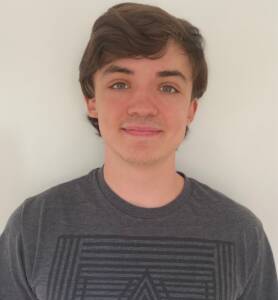
Nicholas Sloan
Graduate Student, Phatnani Laboratory
Tell us about your current role at the NYGC.
I am a second-year graduate student in Dr. Hemali Phatnani’s lab. I have a general interest in understanding the mechanisms behind sporadic neurodegenerative diseases. I am currently involved in a project studying how altered macromolecular crowding on the cellular level potentially leads to protein aggregation and downstream disease progression. My role in this project is characterizing how age-related alterations to the extracellular matrix cause cells to become more vulnerable to neurodegenerative pathology.
What do you enjoy doing besides work?
I have had a passion for ice hockey since I was 7 years old. I currently play for Columbia University’s club ice hockey team. Having grown up in Westchester, NY, I also enjoy watching the New York Rangers play at Madison Square Garden (and watching my colleague Obi’s Boston Bruins lose).
What got you interested in neurodegenerative disease/Alzheimer’s disease research?
My interest for neurodegenerative disease research began at my undergraduate institution, Johns Hopkins University, where I studied the mechanisms of Parkinson’s disease in Dr. Ted Dawson’s lab. I later became interested in the general concepts that connect different neurodegenerative diseases to one another. What factors outside of genetics cause these diseases to occur? Why and how do proteins aggregate in these diseases? What determines cell-type-specific vulnerability? How can loss of specific cell types in the brain produce specific, dissociable behavioral phenotypes?
What, if any, barriers or challenges have you faced in your career?
Learning to focus on the bigger picture rather than dwelling on an experiment that didn’t work or a negative result.
What do you think can be done to make the workplace more inclusive and equitable?
The best research environments are inclusive to those coming from different backgrounds and perspectives. I believe NYGC should make an effort to diversify their candidate pool, and that individual labs should consider hiring team members that approach research in a unique way from the rest of the team.
What advice would you give to your younger self?
Everyone’s journey in research is going to be unique. Don’t worry about sizing yourself up to others and learn to appreciate what makes your path special.
